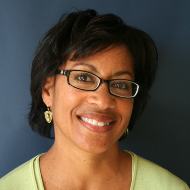Teaching evolution is fundamental to understanding and explaining the diversity of life around us. Supported by multiple lines of evidence, evolution has the broad power to explain biological phenomena on small and large scales. By understanding how evolutionary changes occur, scientists can make accurate predictions about a wide variety of biological systems. From observing the rise of antibiotic-resistant bacteria and producing vaccines for new strains of flu, to recognizing changes in lineages of organisms over geological time, scientists and educators worldwide who research, teach, and learn about evolution are constantly advancing evolutionary theory.
Why Teach Evolution at a Natural History Museum?
Lisa D. White, Director of Education and Outreach at the University of California Museum of Paleontology, explains the role the museum plays in supporting educators' confidence in teaching evolution as well as the impact it hopes to have on learners.
I hope I am inspiring the next generation of scientists to embrace and ultimately teach evolution themselves.
Since Darwin's time, the use of modern technology, experimental tests, and observational studies have expanded our understanding of biological evolution, both uncovering its basis at the molecular level and elucidating its broadest patterns throughout Earth's deep history.
We teach evolution in order to share evidence supporting how the diversity of life has changed and continues to change over time. Evolution is the only well-supported explanation for life's diversity and so scientists accept evolution as sound science. At the University of California Museum of Paleontology (UCMP), we are committed to providing rich scientific content and classroom resources on the Understanding Evolution website for teaching biological evolution with the goal of increasing instructors' confidence in their ability to teach evolution effectively. The website supports all levels in teaching what evolution is, how it works, how it factors in everyday life, how research in evolutionary biology is performed, and how ideas about evolution have changed over time.
As an Earth scientist, micropaleontologist, and UCMP Director of Education and Outreach, I oversee a variety of programs for students, teachers, and the public designed to connect diverse audiences to paleontology and evolutionary science through field programs, museum curation projects, workshops, and interactive exhibits. In these settings I help others construct an understanding of evolution and the fossil record by fostering their fundamental science practices and skills. By supporting learners' ability to make scientific observations, formulate hypotheses, and record and interpret data, I hope I am inspiring the next generation of scientists to embrace and ultimately teach evolution themselves.

